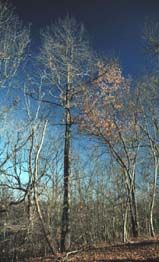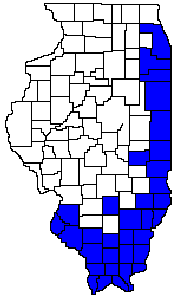 |
| Blackgum
(Nyssa sylvatica)
Distribution
Map to Right |

Black Gum is divided into two groups, Nyssa sylvatica var. biflora, a tree of swamps and bottomlands, and Nyssa sylvatica var. sylvatica, black or sour gum, the one referred to here. This latter one is present in lighter textured soils of uplands and stream bottoms with best growth on stream terraces and slopes. Black gum reaches heights of 75 to 100 feet, with a trunk diameter of up to 3 feet. The base of the tree may be enlarged when it is growing in water. The crown is irregularly rounded, sometimes becoming flat-topped with age.
In Illinois, black gum is present on dry wooded slopes to periodically wet, low woods, particularly flatwoods. Black gum extends from Maine across Michigan and Wisconsin, south to Missouri and Texas, east to northern Florida.
Interesting
Facts
Black
gum fruits are high in crude fat, fiber, and phosphorus and constitute
an important food source for a variety animals, including black bear and
over 30 species of song and game birds. The tree frequently has numerous
cavities that serve as nesting and den spaces for a variety of animals.
Black gum is sometimes confused with persimmon. The trees can be distinguished by their leaves, the black gum having leaves that are abruptly short and pointed at the tip.
Identifying Features
Bark
Black gum bark is light gray when young and becomes darker gray or brown or black when mature. The texture is distinctive. It is thick and blocky, with an "alligator-hide" pattern.
Twigs
The twigs are greenish to reddish-brown when young, becoming grayish with age. They are smooth and at sharp angles to the trunk.
Buds
The buds are small, 1/8 to 1/4 inch in length, oval shaped with sharp points. They are yellow-brown to red-brown and smooth or sparsely hairy at the tip.
Leaves
Black gum leaves are alternate, simple, and from 2-5 inches long. They are oval to elliptic and the edges are not toothed, but either smooth or wavy. They are dark green, shiny, and smooth on the upper surface, and paler and somewhat hairy beneath. They turn a brilliant scarlet, orange, purple, or yellow in the autumn. The leafstalks are up to 1 1/2 inches long.
Flowers
Male and female flowers are borne on separate trees. They are very small and inconspicuous, greenish white, and appear when the leaves unfold in early spring.
Fruits
The fruits are fleshy and oval, and occur 2 - 3 per stalk. They are 1/3 - 1/2 inch long, contain a single seed, are bluish black, and ribbed. In Illinois, they ripen in October.
Uses
Black
gum wood is heavy, strong, and soft. It is used for furniture, lumber pulp,
gunstocks, and flooring. Because of its brilliant autumn color, it is sometimes
planted as an ornamental. The flowers are the source of a honey.